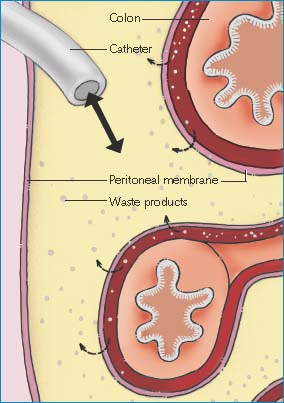Continuous Ambulatory Peritoneal Dialysis
Continuous ambulatory peritoneal dialysis (CAPD) requires insertion of a permanent peritoneal catheter (such as a Tenckhoff catheter) to circulate dialysate in the peritoneal cavity constantly. Inserted under local anesthetic, the catheter is sutured in place and its distal portion is tunneled subcutaneously to the skin surface. There it serves as a port for the dialysate, which flows in and out of the peritoneal cavity by gravity. (See How peritoneal dialysis works.)
How Peritoneal Dialysis Works
Peritoneal dialysis works through a combination of diffusion and osmosis.
Diffusion
In diffusion, particles move through a semipermeable membrane from an area of high-solute concentration to an area of low-solute concentration.
In peritoneal dialysis, the water-based dialysate being infused contains glucose, sodium chloride, calcium, magnesium, acetate or lactate, and no waste products. Therefore, the waste products and excess electrolytes in the blood cross through the semipermeable peritoneal membrane into the dialysate. Removing the waste-filled dialysate and replacing it with fresh solution keeps the waste concentration low and encourages further diffusion.
Osmosis
In osmosis, fluids move through a semipermeable membrane from an area of low-solute concentration to an area of high-solute concentration. In peritoneal dialysis, dextrose is added to the dialysate to give it a higher solute concentration than the blood, creating a high osmotic gradient. Water migrates from the blood through the membrane at the beginning of each infusion, when the osmotic gradient is highest.
 |
CAPD is used most commonly for patients with end-stage renal disease who are looking for an alternative to renal replacement therapy. It can also be used in patients with vascular access issues, chronic heart failure, and ischemic heart disease. This procedure can be a welcome alternative to hemodialysis because it gives the patient more independence and requires less travel for treatments. CAPD also provides more stable fluid and electrolyte levels than conventional hemodialysis.
Patients or family members can usually learn to perform CAPD after appropriate training. And because the patient can resume normal daily activities between solution changes, CAPD helps promote independence and a return to a near-normal lifestyle. It also costs less than hemodialysis.
Conditions that may prohibit CAPD include recent abdominal surgery, abdominal adhesions, an infected abdominal wall, diaphragmatic tears, ileus, and respiratory insufficiency.
Equipment
To Infuse Dialysate
Prescribed amount of dialysate (usually in 2-L bags) ▪ heating pad or commercial warmer ▪ three face masks ▪ 42″ (106.7 cm) connective tubing with drain clamp ▪ six to eight packages of sterile 4″ × 4″ gauze pads ▪ medication, if ordered ▪ antiseptic pads ▪ hypoallergenic tape ▪ plastic snap-top container ▪ antiseptic solution ▪ sterile basin ▪ container of alcohol ▪ gloves ▪ sterile gloves ▪ belt or fabric pouch ▪ two sterile, waterproof paper drapes (one fenestrated) ▪ Optional: syringes, labeled specimen container.
To Discontinue Dialysis Temporarily
Three sterile, waterproof paper barriers (two fenestrated) ▪ 4″ × 4″ gauze pads (for cleaning and dressing the catheter) ▪ two face masks ▪ sterile basin ▪ hypoallergenic tape ▪ antiseptic solution ▪ gloves ▪ sterile gloves ▪ sterile rubber catheter cap.
All equipment for infusing the dialysate and discontinuing the procedure must be sterile. Commercially prepared sterile CAPD kits are available.
Preparation of Equipment
Check the concentration of the dialysate against the doctor’s order. Also check the expiration date and appearance of the solution—it should be clear, not cloudy. Warm the solution to body temperature with a heating pad set on low or a commercial warmer. Don’t warm the solution in a microwave oven because the temperature is unpredictable.
To minimize the risk of contaminating the bag’s port, leave the dialysate container’s wrapper in place during warming. This also keeps the bag dry, which makes examining it for leakage easier after you remove the wrapper.
Perform hand hygiene1,2,3 and put on a surgical mask and follow standard precautions. Remove the dialysate container from the warming setup, and remove its protective wrapper. Squeeze the bag firmly to check for leaks.
If ordered, use a syringe to add any prescribed medication to the dialysate, using sterile technique to avoid contamination. (The ideal approach is to add medication under a laminar flow hood.) Disinfect multiple-dose vials in a 5-minute antiseptic soak. Insert the connective tubing into the dialysate container. Open the drain clamp to prime the tube. Then close the clamp.
Place an antiseptic pad on the dialysate container’s port. Cover the port with a dry gauze pad, and secure the pad with tape. Remove and discard the surgical mask. Tear the tape so it will be ready to secure the new dressing. Commercial devices with antiseptic pads are available for covering the dialysate container and tubing connection.
Implementation
Verify the doctor’s order and that an informed consent was signed.4
Confirm the patient’s identity using at least two patient identifiers according to your facility’s policy.5
Explain the procedure to the patient and answer any questions.
Weigh the patient to establish a baseline level. Weigh him at the same time every day to help monitor fluid balance.
Infusing Dialysate
Gather all equipment at the patient’s bedside. Prepare the sterile field by placing a waterproof, sterile paper drape on a dry surface near the patient. Take care to maintain the drape’s sterility.
Fill the snap-top container with antiseptic solution, label it,6 and place it on the sterile field. Place the basin on the sterile field. Then place four pairs of sterile gauze pads in the sterile basin and saturate them with the antiseptic solution. Drop the remaining gauze pads on the sterile field. Loosen the cap on the alcohol container and place it next to the sterile field.

Stay updated, free articles. Join our Telegram channel

Full access? Get Clinical Tree


Get Clinical Tree app for offline access
